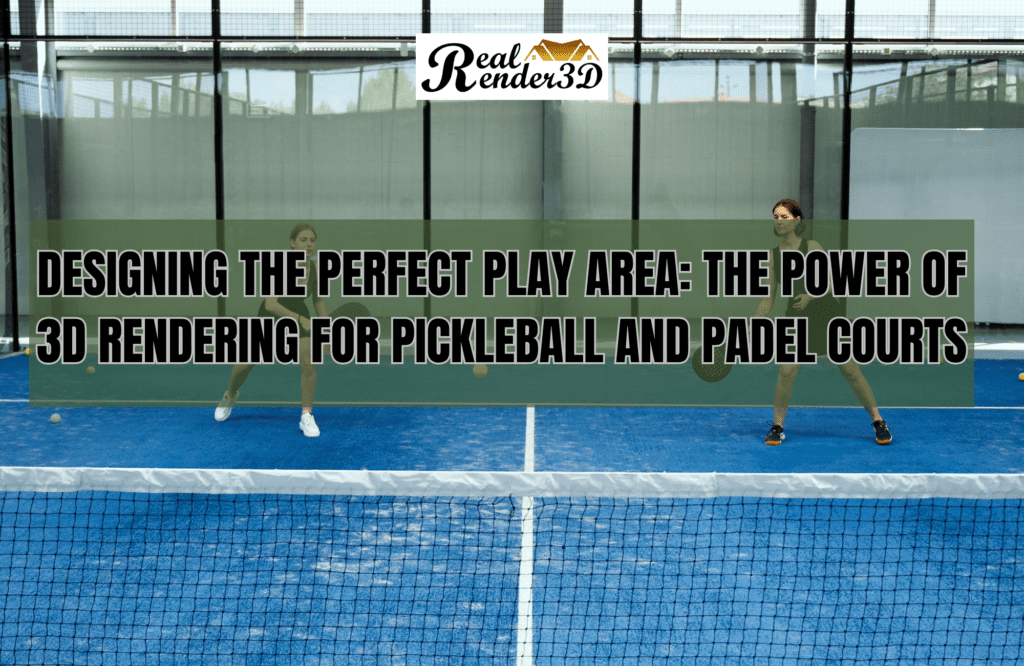Introduction
In recent years, sports like pickleball and padel have surged in popularity, prompting a demand for well-designed, functional courts. Utilising 3D rendering services has become an invaluable tool in the planning and construction of these sports facilities. This blog explores how 3D architectural rendering can transform the design process, ensuring that new sports courts meet both player needs and aesthetic requirements.
Introduction to 3D Architectural Rendering in Sports Facility Design
3D rendering offers a dynamic approach to designing sports facilities, allowing architects and designers to create detailed, accurate representations of pickleball and padel courts before construction begins. This technology not only helps in visualising the space but also in making informed decisions about its functionality and design aesthetics.
Advantages of Using 3D Rendering for Court Design
The use of 3D rendering in designing sports courts brings several benefits:
- Precision and Accuracy: Architects can produce highly accurate and detailed models of the courts, ensuring that every element from the dimensions to the placement of lines is perfectly aligned with official standards.
- Visualisation: Stakeholders can view the proposed designs in a realistic format, making it easier to visualise the end result and make necessary adjustments before physical work begins.
- Enhanced Planning: 3D models allow designers to experiment with different layouts and materials, optimising the use of space and resources.
Improved Communication: Presenting a clear and detailed visual model helps in effectively communicating the design intent to clients, contractors, and regulatory bodies.
The Role of Architectural Visualisation in Enhancing Play Areas
Architectural visualisation plays a crucial role in enhancing the functionality and aesthetics of pickleball and padel courts. It allows designers to:
- Incorporate Specific Features: Essential features such as spectator areas, lighting, and drainage systems can be accurately positioned and visualised in the 3D model.
- Select Appropriate Materials: The impact of different materials on the playability and maintenance of the courts can be assessed visually.
- Assess Environmental Impact: Designers can evaluate how the courts will blend with their surroundings and make adjustments to minimise their environmental footprint.
Key Tools and Software for 3D Court Rendering
To achieve the best results in 3D rendering, several advanced tools and software are employed:
AutoCAD: Widely used for detailed drawings and layouts of sports facilities.
SketchUp: Helps in creating 3D models with an emphasis on textures and details.
Revit: Offers robust architectural planning and rendering capabilities.
Real-World Examples of Successful Court Designs
Case studies of successfully implemented pickleball and padel courts can showcase the effectiveness of 3D rendering in sports facility design. These examples often highlight how potential issues were identified and resolved through the design phase, leading to seamless construction and highly functional sports environments.
Conclusion
The integration of 3D architectural rendering and visualisation techniques in the design and construction of pickleball and padel courts marks a significant advancement in sports architecture. By embracing these technologies, designers and architects can ensure that the sports facilities they create are not only functional and compliant with standards but also aesthetically pleasing and well-integrated into their environments. The power of 3D rendering lies in its ability to turn conceptual designs into tangible realities that meet the evolving demands of sports enthusiasts.
Frequently Asked Questions
1. What is 3D rendering in sports facility design?
3D rendering involves creating digital models of sports facilities, such as pickleball and padel courts, allowing designers to visualize and plan the project before construction begins.
2. How does 3D rendering improve the design of pickleball and padel courts?
It provides precise visualizations, ensures accuracy in dimensions and layout, and allows for adjustments before physical work, enhancing both the functionality and aesthetics of the courts.
3. Can 3D rendering help in choosing materials for sports courts?
Yes, it enables designers to experiment with different materials in the virtual model to determine how they affect the functionality and maintenance of the courts.
4. What are the benefits of architectural visualisation for sports facilities?
Architectural visualisation helps integrate essential features, assess material impacts, and ensure the court blends well with its environment, enhancing both practicality and visual appeal.
5. Which software is commonly used for 3D rendering of sports facilities?
Popular software includes AutoCAD for precise drawings, SketchUp for detailed texturing, and Revit for comprehensive architectural rendering.
6. How does 3D rendering facilitate communication in sports facility projects?
It provides a clear, detailed visual representation of the project, improving understanding and communication among designers, clients, and contractors.
Alex Smith is a content writer at RealRender3D, writing informative articles on 3D rendering, interior design, architecture, and related topics.
With over 15 years of experience at top UK architecture and interior design firms, Alex leverages his expertise to write engaging content educating readers on AEC industry trends and best practices.
Connect with Alex at alex@realrender3d.co.uk.
